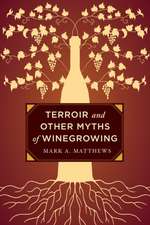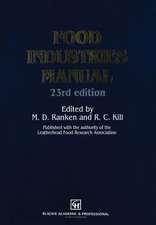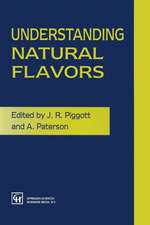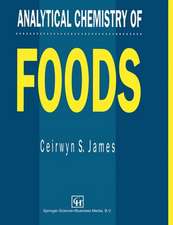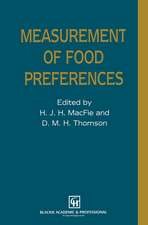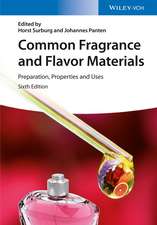Food Analysis: Food Science Text Series
Editat de S. Suzanne Nielsenen Limba Engleză Paperback – 27 mai 2012
| Toate formatele și edițiile | Preț | Express |
|---|---|---|
| Paperback (2) | 533.63 lei 6-8 săpt. | |
| Springer Us – 27 mai 2012 | 533.63 lei 6-8 săpt. | |
| Springer International Publishing – 13 sep 2018 | 566.10 lei 6-8 săpt. | |
| Hardback (1) | 582.15 lei 3-5 săpt. | +76.74 lei 7-11 zile |
| Springer International Publishing – 16 iun 2017 | 582.15 lei 3-5 săpt. | +76.74 lei 7-11 zile |
Din seria Food Science Text Series
- 17%
 Preț: 502.95 lei
Preț: 502.95 lei - 17%
 Preț: 469.18 lei
Preț: 469.18 lei - 15%
 Preț: 549.39 lei
Preț: 549.39 lei - 20%
 Preț: 579.80 lei
Preț: 579.80 lei -
 Preț: 458.78 lei
Preț: 458.78 lei - 13%
 Preț: 358.75 lei
Preț: 358.75 lei - 15%
 Preț: 635.75 lei
Preț: 635.75 lei - 15%
 Preț: 566.10 lei
Preț: 566.10 lei -
 Preț: 396.40 lei
Preț: 396.40 lei -
 Preț: 482.23 lei
Preț: 482.23 lei -
 Preț: 392.37 lei
Preț: 392.37 lei -
 Preț: 398.35 lei
Preț: 398.35 lei - 15%
 Preț: 508.60 lei
Preț: 508.60 lei - 15%
 Preț: 508.75 lei
Preț: 508.75 lei - 15%
 Preț: 587.39 lei
Preț: 587.39 lei - 18%
 Preț: 965.83 lei
Preț: 965.83 lei -
 Preț: 393.13 lei
Preț: 393.13 lei - 15%
 Preț: 532.70 lei
Preț: 532.70 lei - 15%
 Preț: 593.26 lei
Preț: 593.26 lei -
 Preț: 474.31 lei
Preț: 474.31 lei - 15%
 Preț: 658.05 lei
Preț: 658.05 lei - 15%
 Preț: 600.74 lei
Preț: 600.74 lei - 18%
 Preț: 971.22 lei
Preț: 971.22 lei - 15%
 Preț: 477.74 lei
Preț: 477.74 lei - 18%
 Preț: 1010.33 lei
Preț: 1010.33 lei - 15%
 Preț: 477.74 lei
Preț: 477.74 lei - 15%
 Preț: 574.25 lei
Preț: 574.25 lei
Preț: 533.63 lei
Preț vechi: 627.80 lei
-15% Nou
Puncte Express: 800
Preț estimativ în valută:
102.12€ • 105.50$ • 84.99£
102.12€ • 105.50$ • 84.99£
Carte tipărită la comandă
Livrare economică 25 martie-08 aprilie
Preluare comenzi: 021 569.72.76
Specificații
ISBN-13: 9781461425892
ISBN-10: 1461425891
Pagini: 616
Ilustrații: XIV, 602 p. 271 illus.
Dimensiuni: 210 x 279 x 38 mm
Greutate: 1.37 kg
Ediția:Softcover reprint of hardcover 4th ed. 2010
Editura: Springer Us
Colecția Springer
Seria Food Science Text Series
Locul publicării:New York, NY, United States
ISBN-10: 1461425891
Pagini: 616
Ilustrații: XIV, 602 p. 271 illus.
Dimensiuni: 210 x 279 x 38 mm
Greutate: 1.37 kg
Ediția:Softcover reprint of hardcover 4th ed. 2010
Editura: Springer Us
Colecția Springer
Seria Food Science Text Series
Locul publicării:New York, NY, United States
Public țintă
ResearchCuprins
General Information.- to Food Analysis.- United States Government Regulations and International Standards Related to Food Analysis.- Nutrition Labeling.- Evaluation of Analytical Data.- Sampling and Sample Preparation.- Compositional Analysis of Foods.- Moisture and Total Solids Analysis.- Ash Analysis.- Fat Analysis.- Protein Analysis.- Carbohydrate Analysis.- Vitamin Analysis.- Traditional Methods for Mineral Analysis.- Chemical Properties and Characteristics of Foods.- pH and Titratable Acidity.- Fat Characterization.- Protein Separation and Characterization Procedures.- Application of Enzymes in Food Analysis.- Immunoassays.- Analysis of Food Contaminants, Residues, and Chemical Constituents of Concern.- Analysis for Extraneous Matter.- Determination of Oxygen Demand.- Spectroscopy.- Basic Principles of Spectroscopy.- Ultraviolet, Visible, and Fluorescence Spectroscopy.- Infrared Spectroscopy.- Atomic Absorption Spectroscopy, Atomic Emission Spectroscopy, and Inductively Coupled Plasma-Mass Spectrometry.- Nuclear Magnetic Resonance.- Mass Spectrometry.- Chromatography.- Basic Principles of Chromatography.- High-Performance Liquid Chromatography.- Gas Chromatography.- Physical Properties of Foods.- Rheological Principles for Food Analysis.- Thermal Analysis.- Color Analysis.
Notă biografică
S. Suzanne Nielsen, a Professor in the Food Science Department at Purdue University, has taught Food Analysis lecture classes for 32 years, and Food Analysis laboratory courses for 19 years. She has received teaching awards from her department, college, university, and the Institute of Food Technologists. She has edited five editions of a textbook and three editions of a laboratory manual for Food Analysis.
Textul de pe ultima copertă
This fifth edition provides information on techniques needed to analyze foods for chemical and physical properties. The book is ideal for undergraduate courses in food analysis and is also an invaluable reference to professionals in the food industry. General information chapters on regulations, labeling, sampling, and data handling provide background information for chapters on specific methods to determine chemical composition and characteristics, physical properties, and objectionable matter and constituents. Methods of analysis covered include information on the basic principles, advantages, limitations, and applications. Sections on spectroscopy and chromatography along with chapters on techniques such as immunoassays, thermal analysis, and microscopy from the perspective of their use in food analysis have been expanded. Instructors who adopt the textbook can contact the editor for access to a website with related teaching materials.
Caracteristici
New edition of well-known textbook Invaluable reference for professionals in industry Teaching materials available via editor

